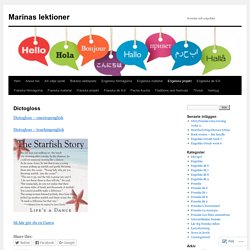

Using dictogloss to focus on used to and would for past habits; talking about childhood memories. Etf 52 2 12 19 and 35. Great Idea: Dictogloss. Dictogloss. The aim of a dictogloss is for a group of students to recreate a heard text by taking notes and pooling knowledge within a small group to reconstruct it in written form.
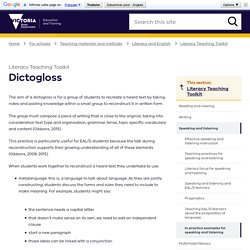
The group must compose a piece of writing that is close to the original; taking into consideration text type and organisation, grammar, tense, topic specific vocabulary and content (Gibbons, 2015). This practice is particularly useful for EAL/D students because the talk during reconstruction supports their growing understanding of all of these elements (Gibbons, 2009; 2015). When students work together to reconstruct a heard text they undertake to use: metalanguage: this is, a language to talk about language. As they are jointly constructing, students discuss the forms and rules they need to include to make meaning. Procedure for introducing the dictogloss strategy Amazing Animals of Australia's National Parks by Gina Newton, NLA Publishing, 2017 1.
For example, Information reports are the writing focus. 2. 3. 4. E.g. Dictogloss. Dictogloss / Listening and speaking strategies / Oral Language / ESOL teaching strategies / Resources for planning / Planning for my students' needs / ESOL Online / English - ESOL - Literacy Online website - English - ESOL - Literacy Online. Choose a text that suits the level of the learners.
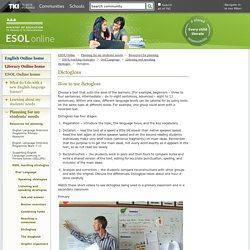
(For example, beginners – three to four sentences, intermediate – six to eight sentences, advanced – eight to 12 sentences). Within one class, different language levels can be catered for by using texts on the same topic at different levels. For example, one group could work with a recorded text. Dictogloss has four stages: Dictogloss. Image credit: www.biography.com This is a lesson plan designed to help students practice past narrative tenses.

The topic is remembering where you were when big events happened. Download the teacher’s notes and student handout below: Where were you when student handout Where were you when Teachers notes Lead-in Show image of MJ. Using ESL Library Podcasts for Dictogloss Activities – ESL Library Blog. Experimental Practice Dictogloss Lesson Plan Main. Kristinaasker. Dictogloss. Skip to content Dictogloss is a classroom dictation activity where learners are required to reconstruct a short text by listening and noting down key words, which are then used as a base for reconstruction.
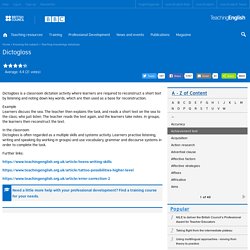
ExampleLearners discuss the sea. The teacher then explains the task, and reads a short text on the sea to the class, who just listen. The teacher reads the text again, and the learners take notes. In groups, the learners then reconstruct the text. In the classroomDictogloss is often regarded as a multiple skills and systems activity. Further links: Need a little more help with your professional development? © British Council, 10 Spring Gardens, London SW1A 2BN, UK © BBC World Service, Bush House, Strand, London WC2B 4PH, UK ShareThis Copy and Paste. TEFL Lesson Plans For Dummies - Michelle M. Maxom - Google Böcker. Nothing is as it seems - dictogloss worksheet. Teenagers: Writing: Dictogloss. An activity with a focus on communicating meaning and using correct grammar.
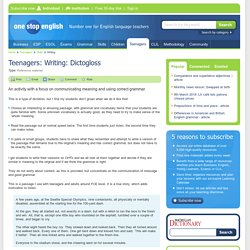
This is a type of dictation, but I find my students don’t groan when we do it like this! Choose an interesting or amusing passage, with grammar and vocabulary items that your students are quite familiar with. Some unknown vocabulary is actually good, as they need to try to make sense of the ‘whole’ meaning.Read the passage out at normal speed twice. The first time students just listen, the second time they can make notes.In pairs or small groups, students have to share what they remember and attempt to write a version of the passage that remains true to the original’s meaning and has correct grammar, but does not have to be exactly the same. I get students to write their versions on OHTs and we all look at them together and decide if they are similar in meaning to the original and if we think the grammar is right.
This is a passage I use with teenagers and adults around FCE level. Dictogloss. Dictogloss. The Best Resources For Learning How To Use The Dictogloss Strategy With English Language Learners. Dictogloss is primarily a listening and writing activity used with English Language Learners.
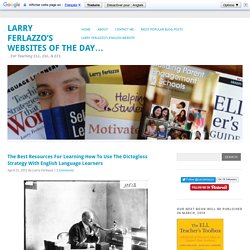
It can certainly be done a number of different ways but, very simply-put, the teacher reads a short text, often one students are familiar with. Then, after the first time of just listening, the teacher reads it again and students write down notes of what they have heard. Next, the teacher reads it a third time and, again, the student writes down additional notes. The student then compares his/her notes with another student’s notes and they work together to develop an accurate reconstruction of the text — one that is not necessarily the exact wording, but that demonstrates its meaning accurately. Finally, the teacher reads it again and students judge how well they did. Again, there are many variations on how to implement this engaging instructional strategy. Here are few of the best resources that I’ve found on using the dictogloss strategy. Using ESL Library Podcasts for Dictogloss Activities. A dictogloss is a classroom activity that incorporates listening, writing, speaking, and reading skills.
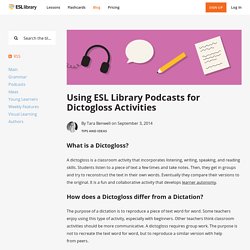
Marinas lektioner. Marinas lektioner franska och engelska.
